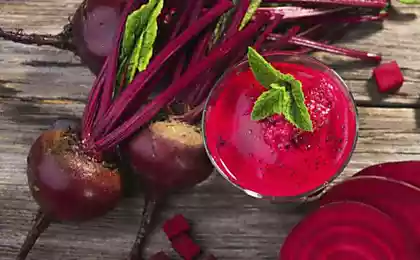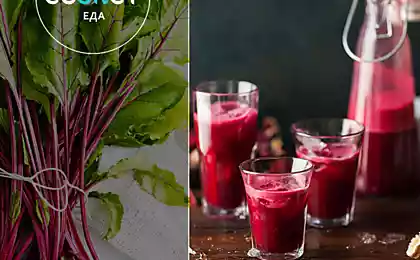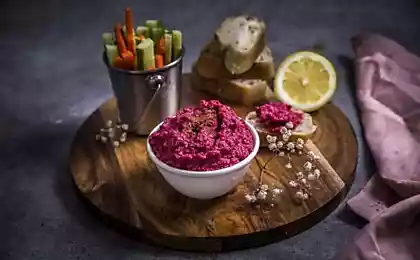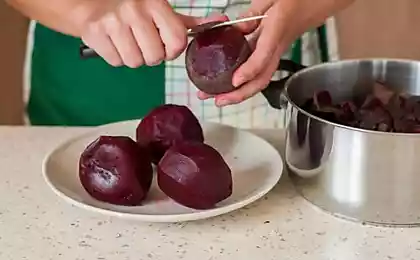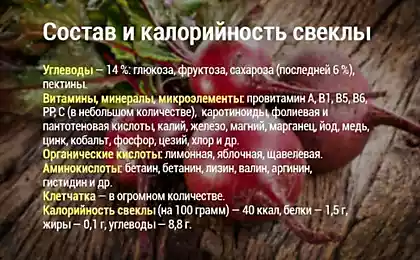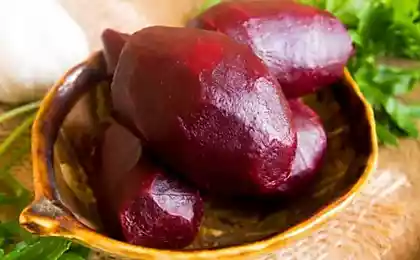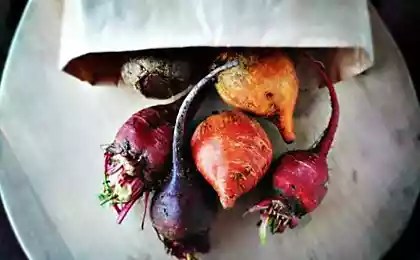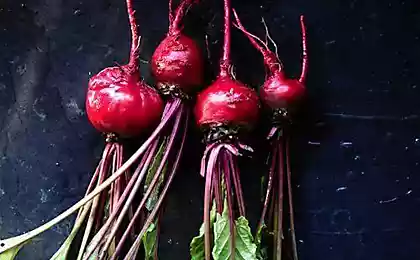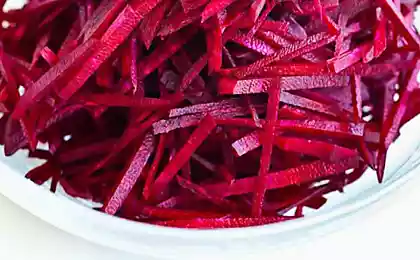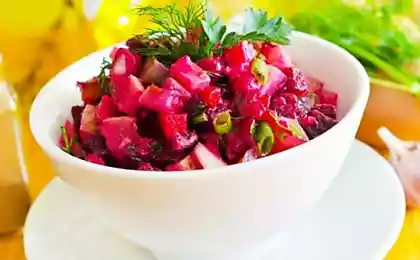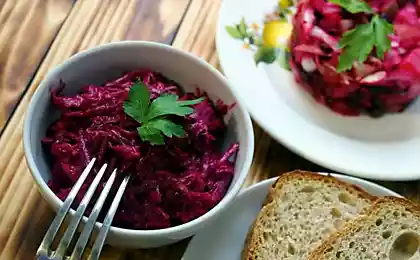564
Amazing anti-aging properties of beets

Winter came. Fresh vegetables and fruits in the diet was less. But beets enough. This does, at first glance, a root vegetable contains unique antioxidant pigments. His roots and herbs to protect from coronary artery disease, reduce cholesterol in the body and slow the aging process.
Botanists consider this plant to the family Amarathaceae. Its scientific name is Beta vulgaris. On resource Nutrition And You about the beetroot and its properties said many interesting things.
Beet is a small herbaceous plant with dark green leaves. The gestation period of its roots is 50-60 days. Each beet weighs between 100 and 150 grams. Of course, it can be smaller and larger. If you do not harvest beets in time, it will continue to increase in size and will weigh approximately half a kilo. The roots will crack. As a result, it will be tasteless and unattractive. In overripe beet contains an excess of fiber.
Beets is red, yellow, orange and white. Red-crimson color of the beets provided betalaines pigments, such as betanin and betacyanin. Yellow variety of this vegetable gets its color due to the pigment betaxanthins. In the food used soft roots and beet greens. Grade Choggia beet is characterized by alternating circles of red and white flowers.
The benefits of beets health

Garden beet is very low in calories (just 45 calories per 100 grams) and no cholesterol. It includes only a small amount of fat. It contains fiber, vitamins, minerals and antioxidants.
Beetroot is a rich source of phytochemical compound, glycine betaine. Betaine has the ability to reduce blood levels of homocysteine. Homocysteine, a highly toxic intermediate product of the metabolism, stimulating the development of blood clots, as well as contributing to the formation of atherosclerotic plaques that damage the blood vessels. High level homocysteine in the blood leads to the development of coronary heart disease, heart attack and peripheral vascular disease.
Raw beetroot is an excellent source of folate. It contains this vitamin approximately 109 micrograms per 100 grams (27% of the recommended daily norms of consumption). During cooking, the folate content in food is greatly reduced. Folate is necessary for DNA synthesis in cells. Eating folate in preconceptional period, it is possible to prevent a defect in the neural tube of the child.
In the roots of beets also contains small amounts of vitamin C. But its greens are an excellent source of this vitamin and contains 100 grams of 30 milligrams of vitamin C, or 50% of the recommended daily allowance. Vitamin C is one of the most powerful natural antioxidants help the human body cleanse itself from harmful free radicals, which are one of the causes of cancer.
Additionally, beet greens are an excellent source of carotenoids, flavonoid antioxidants and vitamin A. These compounds in beet greens contains several times more than the roots of this plant. Vitamin A is essential for maintaining healthy mucous membranes and skin. It is also necessary for healthy vision. Consumption of flavonoid-rich natural vegetables helps protect against lung cancer and oral cavity.
The roots of beets also act as a source of B vitamins such as Niacin (B3), Pantothenic acid (B5), pyridoxine (B6). In the beet contains minerals such as iron, manganese, copper and magnesium.
Beet roots moderate amount also contain potassium 325 milligrams per 100 grams of fresh root or 7% of the recommended daily allowance. Potassium lowers heart rate and regulates cellular metabolism, counteracting the damaging effects of sodium.
How to choose beets?
In the store or on the market give preference to fresh, bright and crisp beet with intense colour and formless. Avoid soft, overripe and large beets.
If you buy beets with greens, separate the greens from the roots as quickly as possible. This is required because the greens pull nutrients and moisture from roots.
Beet, like any other edible greens should be washed under running water and place in half an hour in salt water in order to wash greens the earth, sand, dirt or insecticide residues.
Beet greens should be used fresh. Beet roots can be stored in the refrigerator for several weeks. The roots of the beets should also be washed thoroughly.
Beetroot in cooking

Not only roots, but the greens and beet stems are used in cooking.
Gently scrub and wash beets under running water to wash away soil, sand and dirt. Using a special knife for cleaning of vegetables, remove the beet skins. Cut it in such a way as provided by the recipe of the dish you intend to cook.
Raw beetroot is excellent in salads with carrots, radishes, cucumbers and cabbage and also other vegetables. You can cut beets diced and steamed and then served with butter. In the Southern U.S., pickled beets are a traditional food. Beet juice is a popular drink among those who appreciate a healthy lifestyle.
In India, beet roots combined in curries with other vegetables, which among others include tomatoes, carrots and potatoes.
In Europe, sliced boiled beets seasoned with olive oil, vinegar or lemon juice.
Beetroot is one of the most important ingredients of the soup.
Pigments-betanin derived from beets, is used in industry as dyes. They are used to give a more saturated color tomato paste, sauces, desserts, jams and jellies, ice cream and sweets, and other dishes.
Warnings
After eating beets your urine may acquire a reddish or pinkish hue. As noted on the pages of the website Nutrition And You, it is not dangerous. Similar side effects beets have on 10-15% of the population. This is a genetically determined condition that is called "beeturia" caused by the fact that the body does not decompose the pigment betacyanin.
Beet greens contain oxalic acid, which can have some people to crystallize and form oxalate stones in the urinary tract. People who have in the urinary tract have oxalate stones, do not recommend to get carried away with herbs. Oxalic acid is also found in some other vegetables.
Nutritional value of beets

In parentheses are the percentage of the daily allowance. Nutritional value is based on 100 grams of fresh raw beets according to information from the Ministry of agriculture of the United States.
General information:
energy value — 42 calories (2%);
carbohydrates — of 9.56 grams (7%);
protein of 1.61 grams (1%);
fats and 0.17 grams (0,5%);
cholesterol — 0 milligrams (0%);
fiber, part of the food — 2,80 gram (7%).
Vitamins:
folate — 109 micrograms (27%);
nicotinic acid — 0,334 milligrams (2%);
Pantothenic acid — 0,155 mg (3%);
pyridoxine (vitamin B6) — 0.067 milligram (5%);
Riboflavin (vitamin B2) — 0,057 mg (4%);
thiamine (vitamin B1) — 0.031 milligrams (2,5%);
vitamin A — 33 international units (IU, IU) — 1%;
vitamin C — 4.9 milligrams (0,5%);
vitamin E — 0.04 milligram (0,5%);
vitamin K — 0.2 micrograms (~0%).
Electrolytes:
sodium — 78 mg (5%);
potassium — 325 mg (7%).
Minerals:
calcium, 16 milligrams (1,5%);
copper is 0.075 milligrams (8%);
iron — 0.80 milligrams (10%);
magnesium 23 mg (6%);
manganese — 0,329 mg (14%);
zinc — 0.35 mg (3%).
Phytonutrients:
beta-carotene (ß-carotene), which is rich in carrots — 20 micrograms;
betaine — 128,7 mg;
lutein-zeaxanthin 0 micrograms.
What the beets do you love? Do you think this vegetable is essential in the daily diet? Whether you consider it to delicious and healthy food or not too good, but useful?
Source: hi-news.ru
Pediatrician françoise Berthoud on child health without vaccination
3-D tehnologii in cooking: chocolate confectionery to the burgers
